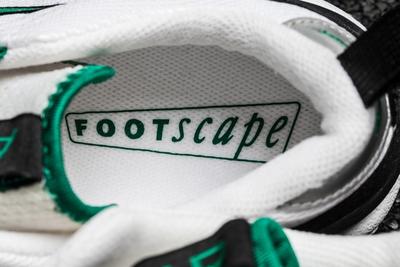Retro Runner Rehab: The Nike Air Stasis
‘Retro Runner Rehab’ is a column where we bungee into the world of bygone running shoes, scoop up our favourites and throw them back in the spotlight. Given that there are so many discontinued running models with extra mileage left in them that you could line them up heel-to-toe and you’d have a distance Forrest Gump wouldn’t want to run, it looks like we won’t be checking out of rehab anytime soon.
You’ve probably heard of Nike’s Air Footscape, they’re everywhere. But have you heard of the Air Stasis? The Stasis is to the Footscape what any prototype is to its base model – an adventurous and optimistic build informed by tenets of design inherent to the brand. They often cause a ruckus among dreamers but, being years ahead of their time, they don’t get traction with the public and are shelved until the world is ready. In a nutshell, this is what happened with the Nike Air Stasis.
However, it’s been 20 years since these runners were first laterally laced. And if in 2016 we live in a world where even the ambitiously hoof-toed Air Rift has found a following, we say the world is ready for an en masse Stasis revival.
As is the case with the Air Max2 Light, the Stasis can’t claim to have pioneered its most provocative feature. Instead – it finessed it. Following the lead of most iconic Nike designs, the lateral lacing system of the Stasis began as a performance feature. Dreamed up by the footscaper himself, Tory Orzeck, the tech was originally pitched as an orthopaedic development. A pitch that was met with a hard ‘No’. In with Orzeck, he remembered his superiors saying ‘We are about performance’. Reasoning being that lateral lacing was aimed at the disabled, not the performance athlete. But Orzeck reworked his pitch to highlight that a lateral lacing system has very real benefits to athletes who over pronate. Which is to say, athletes who run on the medial side of their foot. This style of running is recognised by a slight waddle it can produce in a gait. Flat-footed people (most people) tend to do it, and it results in in-bent knees which causes unnecessary stress on supporting ligaments.
After replacing ‘orthopaedic’ with ‘good for runners’ Orzeck’s superiors in turn replaced their ‘No,’ for a resounding ‘Yes.’ In ’95 the Air Footscape was the star of Nike’s Holiday Footwear catalogue and in winter of ’96-’97 it evolved into the stauncher Air Stasis.
The new design had everything the Footscape had. The anatomically correct, full- length contoured Phylon midsole was employed. As was the one-piece breathable mesh upper. What made the Stasis such a leap forward was that it took its predecessor’s form and exaggerated it.
Where the Footscape was modern, the Stasis was postmodern. The sneakersock chassis was built on with wavy overlays, a more pronounced toe box and scythe-like Swooshes plastered asymmetrically on the ribbed sides of its forefoot. Most importantly, it looks like Nike's design team simply had fun making the it.
The Air Stasis made a return in ’97 in the same ‘White/Malachite’ colour for men, but the women’s ‘Ultramarine/Gold’ did not – and by ’98 the plug was pulled on the line altogether. Nike may have been cusp of an industry changing eureka moment with sneakersocks but that doesn’t mean they weren’t immune to mistakes – this was a time when they still had an entire section of shoes dedicated to street hockey. We can’t say for sure why the Nike Air Stasis was discontinued, but the decision was probably made by whoever OK’d those boots.
Mistakes can be rectified though. Nike love to bring models back after the magic double decade mark – just look at 2016’s Uptempo revival. We didn’t say exactly how many years the Stasis was ahead of its time, but we figure it was roughly 20. And with this holiday season being the Stasis’ 20th year out of action, we think it’s a perfect time for this retro runner to be reissued.







